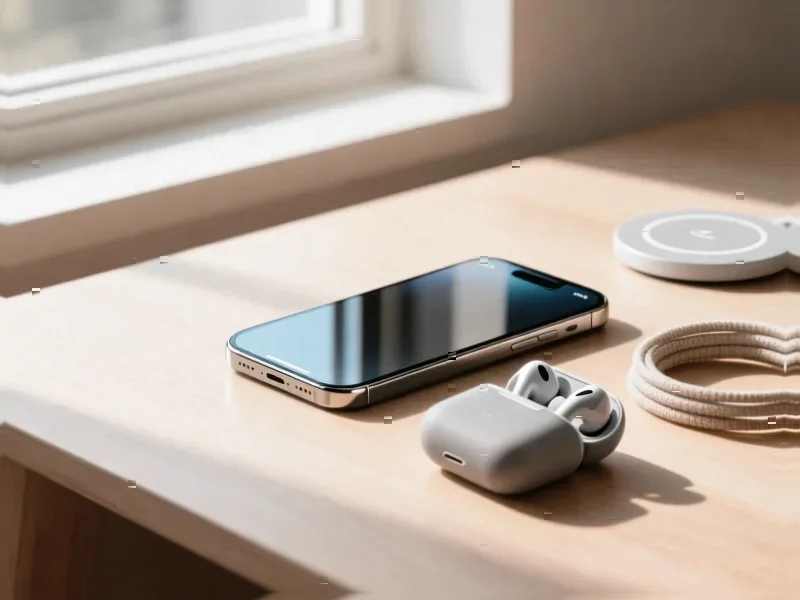According to MacRumors, Apple retail employees have been instructed to prepare for an overnight store refresh on November 11, with new displays and product placements expected to be ready by November 12. The report, citing Bloomberg’s Mark Gurman, notes that dwindling inventory for Apple TV and HomePod mini suggests these products are most likely to receive updates featuring new A17 Pro chips and Apple-designed wireless components with Wi-Fi 6 or Wi-Fi 7 support. The timing aligns with Apple’s typical product refresh patterns, though Gurman cautions this could simply be holiday season preparation. These potential updates would showcase new Siri and Apple Intelligence features planned for 2025, according to the report. This retail activity comes as Apple positions itself for the crucial holiday shopping season.
The Services Ecosystem Play
What makes this refresh strategically significant isn’t just the hardware updates but how they fit into Apple’s broader revenue diversification strategy. While iPhone sales remain Apple’s cash cow, growth has plateaued in mature markets, forcing the company to find new revenue streams. The Apple TV and HomePod mini serve as gateway devices into Apple’s services ecosystem, which has become the company’s second-largest revenue category. Updated hardware with enhanced Siri capabilities creates more touchpoints for Apple Music, Apple TV+, and potential future subscription services. Each HomePod or Apple TV sold represents another household potentially subscribing to multiple Apple services, creating recurring revenue that’s more predictable than one-time hardware sales.
The Smart Home Chess Move
Apple’s timing reveals a calculated effort to capture more of the smart home market before holiday shopping peaks. The inclusion of Apple-designed wireless chips with advanced Wi-Fi capabilities suggests Apple is building a more integrated home ecosystem that could eventually challenge Amazon’s Alexa and Google Assistant dominance. By controlling both the hardware and wireless communication protocols, Apple can ensure better synchronization between devices—a common pain point in smart homes using mixed-brand products. This approach mirrors Apple’s successful walled-garden strategy with iPhones, creating an ecosystem where Apple devices work seamlessly together while making it less appealing to mix in competitors’ products.
Holiday Season Positioning Against Tech Giants
The November timing is particularly strategic given the competitive landscape. Amazon typically dominates Black Friday with aggressive Echo device pricing, while Google pushes its Nest lineup. By refreshing products just before the holiday shopping season, Apple positions itself to capture premium customers who want the latest technology rather than discounted older models. The expected A17 Pro chip in Apple TV would significantly outperform competitors’ streaming devices, allowing Apple to maintain its premium positioning while potentially justifying higher price points. This follows Apple’s pattern of not competing on price but rather on performance and ecosystem integration.
Revenue Implications Beyond Hardware
While the hardware updates themselves will generate revenue, the bigger financial story lies in the services attachment rate. Each Apple TV sold represents potential Apple TV+ subscriptions, App Store purchases, and gaming revenue. Similarly, HomePod minis drive Apple Music subscriptions and could become central to future smart home service offerings. As Apple’s recent earnings showed, services revenue continues to be the growth engine, and these refreshed devices serve as additional conduits into that high-margin business. The timing also suggests Apple wants these updated devices in market before announcing broader Apple Intelligence features in 2025, creating a hardware foundation for software services to come.
Why November Matters for Apple’s 2025 Roadmap
The November refresh timing is crucial for Apple’s 2025 strategy. By updating these products now, Apple ensures they’re positioned as “current generation” throughout the holiday season and into next year when major software updates arrive. This creates a product cycle where hardware refreshes precede significant software enhancements, encouraging repeat engagement from existing customers. It also allows Apple to gather user data and refine its approach before rolling out more ambitious smart home initiatives. With CEO Tim Cook indicating no new Macs until 2026, these home products become even more important for maintaining product excitement and revenue momentum through 2025.




